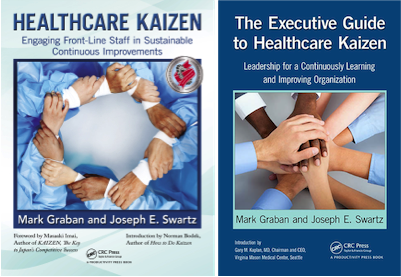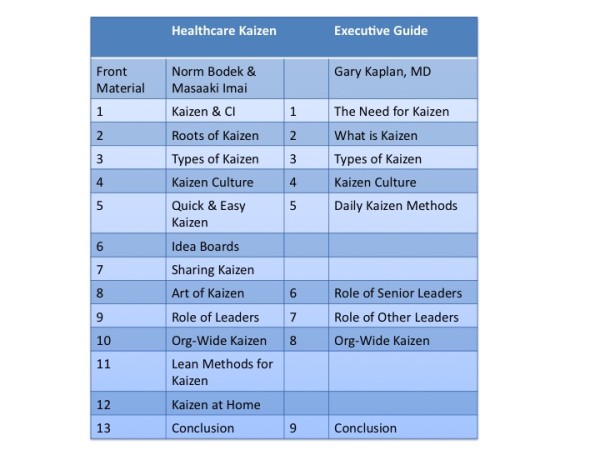How to Use the “Healthcare Kaizen” Books Together
Two great books that work great together
In a nutshell:
The Executive Guide to Healthcare Kaizen is a 200-page overview targeted toward senior leaders and middle managers, focused on creating a sustaining a culture of continuous improvement.
Healthcare Kaizen is a longer, more-detailed book with 200 full-color illustrations (including Kaizen examples) and detailed how-to instructions for starting and managing a Kaizen program.
There is quite a bit of common content between the two books to ensure a consistent message to all audiences.
The details:
Joe Swartz and Mark Graban built upon their well-received (and Shingo Research Award-winning) book Healthcare Kaizen with a new special edition aimed at busy senior leaders: The Executive Guide to Healthcare Kaizen: Leadership for a Continuously Learning and Improving Organization.
The full Healthcare Kaizen book is over 400 pages. Because of all of the full-color photos, the publisher used thick glossy paper.. which means the book weighs in at almost four pounds… the voice of the customer (or at least some customers) said that’s too heavy…
We’ve had readers, like an internal Lean consultant or process improvement director at a hospital, say that the book is great, but it’s too much (and, again, too heavy) to give to a CEO or senior leader to read on a flight.
Joe and I gave that a lot of thought and our publisher agreed with us that we could do a special edition (technically a new book) and keep Healthcare Kaizen on the market, of course.
Starting with that customer need, I benchmarked two popular healthcare books, namely Dr. John Toussaint’s two excellent books On the Mend and Potent Medicine. Those books are smaller and lighter (even as hardcover books). Based on the smaller page size and number of pages, we used that as the vision for The Executive Guide to Healthcare Kaizen.
We worked backward to prioritize the content that would be most useful to time-crunched senior leaders. We included some material from Healthcare Kaizen, re-wrote some material to be aimed at senior leaders, AND wrote some new material especially for them, including Chapter 1 material on “why Kaizen?” and more about the ROI of a Kaizen program (which includes more than just financial results). We’ve also left out some of the “how to” detail while focusing more on the role of leaders in creating a culture of continuous improvement. The Executive Guide also has just a handful of real Kaizen examples, compared to over 100 in the larger book.
You can download a free PDF file that includes:
- Chapter 1 of the new book
- A comparison of the two books
- Detailed table of contents for The Executive Guide
- 20% discount codes to be used when ordering any of my books through the publisher, Productivity Press.
Click here to register to receive the PDF immediately via email.
We hope the difference between the two books is clear as this is something we want to be careful about in our marketing. We hope that The Executive Guide, being a less expensive book (currently $23 at Amazon) will help introduce new audiences to the power of the Kaizen improvement methodology. We can imagine a healthcare organization buying many copies of The Executive Guide and then having one (or a handful) of the larger Healthcare Kaizen book with all of its examples to be shared and passed around.


